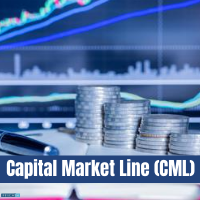Capital Market Line (CML)
What is the Capital Market Line (CML)?
Capital Market Line (CML) is about portfolios that properly combine both risk and return. It is a graph that represents a Portfolio’s expected return based on a level of risk given. This is a special version of the Capital Allocation Line (CAL).

The portfolios on the CML optimise the risk and return relationship. This maximises the performance. The slope CML is the Sharpe Ratio of the market portfolio. It is usually said that one should buy assets if the Sharpe ratio is above the CML and sell if the same is below the CML.
The efficient frontier is more popular than CML, however, both are completely different. Efficient frontier includes risk-free investments. The intercept point of the CML and efficient frontier would result in the tangency portfolio, which makes it the most efficient portfolio.
Often people confuse the capital market line with the Security Market Line (SML). The security line is derived from the capital market line. CML shows portfolio rates of return, whereas SML represents a market risk as well as given time’s return.
Capital Market Line (CML) History
Harry Markowitz and James Tobin pioneered the mean-variance analysis. In 1952, The efficient frontier of optimal portfolios was identified by Markowitz.
Soon after, in 1958, James Tobin included the risk-free rate to modern portfolio theory. Another pioneer, William Sharpe developed the CAPM in the 1960s. He also won a Nobel prize for his work.
Talk to our investment specialist
Capital Market Line (CML) Equation
E(Rc) = y × E(RM) + (1 – y) × RF
E(Rc)= the expected return of the portfolio
E(RM)= the expected return of the market portfolio
RF= the expected return of the market portfolio
All efforts have been made to ensure the information provided here is accurate. However, no guarantees are made regarding correctness of data. Please verify with scheme information document before making any investment.












